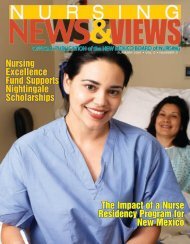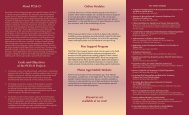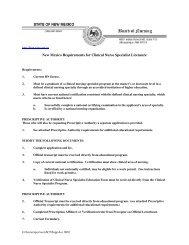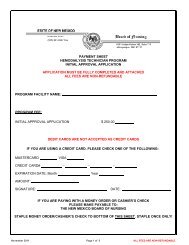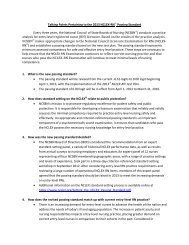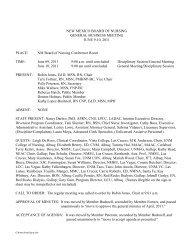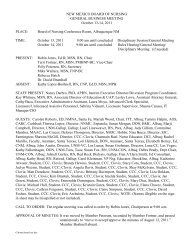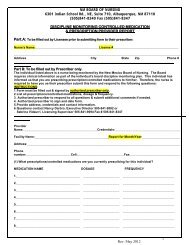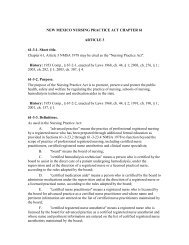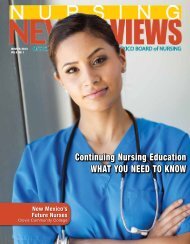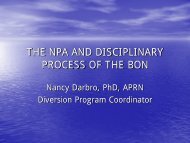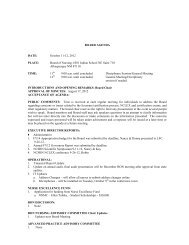Substance Abuse and Nurses - the New Mexico Board of Nursing
Substance Abuse and Nurses - the New Mexico Board of Nursing
Substance Abuse and Nurses - the New Mexico Board of Nursing
You also want an ePaper? Increase the reach of your titles
YUMPU automatically turns print PDFs into web optimized ePapers that Google loves.
<strong>Substance</strong> <strong>Abuse</strong>, <strong>Nurses</strong> <strong>and</strong><br />
<strong>the</strong> Diversion Program<br />
Nancy Darbro, PhD, APRN, CNS<br />
<strong>New</strong> <strong>Mexico</strong><br />
Diversion Program Coordinator
Introduction<br />
• Theories <strong>of</strong> Addiction<br />
• Disease concept<br />
• Barriers to identification <strong>and</strong> intervention<br />
• Impairment<br />
• Prevalence<br />
• Identification: signs <strong>and</strong> symptoms<br />
• Risk factors<br />
• DP monitoring, recovery <strong>and</strong> relapse
Theories <strong>of</strong> addictions (43 in 1980,<br />
Letteri, Sayers & Parson, 1980)<br />
• Psychoanalytic <strong>the</strong>ory (inadequate,<br />
dependent personality)<br />
• Cognitive-behavioral <strong>the</strong>ory (learned<br />
behavior <strong>and</strong> conditioned responses)<br />
• Interpersonal <strong>the</strong>ory (social environment<br />
<strong>of</strong> family <strong>and</strong> peer groups)<br />
• Neurobiologic <strong>the</strong>ory (brain biochemistry<br />
leads to tolerance, craving =brain disease)
Multifactorial Model <strong>of</strong> Addiction<br />
• Complexity <strong>of</strong> addiction supports a<br />
multifactorial approach<br />
• Inclusive vs. exclusive<br />
• Research supports multiple causes<br />
• Addiction is more than a personality<br />
deficit, behavioral problem, genetic<br />
disorder, family dysfunction or product <strong>of</strong><br />
culture. It is a combination <strong>of</strong> all <strong>of</strong> <strong>the</strong>se.
Disease Concept <strong>of</strong> Addiction:<br />
DSM IV Definition<br />
• <strong>Abuse</strong>: any use <strong>of</strong> drugs that causes physical,<br />
psychological, economic, legal or social harm to <strong>the</strong><br />
individual user or to o<strong>the</strong>rs affected by <strong>the</strong> drug user’s<br />
behavior.<br />
• 1. recurrent substance use resulting in failure to fulfill<br />
major role obligations at work, school or home<br />
• 2. recurrent substance use in situations in which it is<br />
physically hazardous, (driving, neglect <strong>of</strong> children,<br />
providing care while impaired)<br />
• 3. recurrent substance related legal problems ( arrests,<br />
child support arrears)
Disease Concept <strong>of</strong> Addiction<br />
• <strong>Substance</strong> Dependence: DSM IV<br />
1. Tolerance<br />
2. Withdrawal<br />
3. Taken in larger amounts <strong>and</strong> over longer<br />
period than intended<br />
4. Persistent desire or unsuccessful efforts to cut<br />
down or control use<br />
5. Preoccupation in obtaining substance<br />
6. Neglect <strong>of</strong> o<strong>the</strong>r activities<br />
7. Continued use despite harmful consequences
Disease Concept <strong>of</strong> Addiction<br />
1. Primary- genetic predisposition, brain<br />
disease<br />
2. Progressive- ongoing deterioration,<br />
marked by early, middle <strong>and</strong> late stage<br />
3. Chronic- relapsing medical condition<br />
4. Fatal-accidental or medical complications
Primary<br />
• Twin studies<br />
• Family genetics<br />
• Brain research-neurobiological changes<br />
• Males <strong>of</strong> alcoholic fa<strong>the</strong>rs have<br />
constitutional differences in effect <strong>of</strong> <strong>and</strong><br />
elimination <strong>of</strong> alcohol<br />
• Genetic factors account for 40%-60% <strong>of</strong><br />
vulnerability to addiction (NIDA, 2007)
Progressive<br />
• Review <strong>of</strong> Jellinik chart h<strong>and</strong>out<br />
• Applies to addictive process, not abuse<br />
• Progressive deterioration<br />
• Defense mechanisms are unconscious<br />
• Lack <strong>of</strong> insight is perplexing to outsiders<br />
• Physiological changes/brain changes due to<br />
neurotransmitters <strong>and</strong> receptor sites<br />
• Recovery is progressive too
Chronic<br />
• Neurobiology <strong>of</strong> addiction<br />
• Use for pleasurable effect (reward) or positive<br />
reinforcement<br />
• Continued seeking <strong>of</strong> pleasure/reward<br />
• Sensitization or adaptation to reward (tolerance)<br />
• Use to avoid adverse effects (withdrawal) or negative<br />
reinforcement<br />
• Rewarded behavior is reinforcing behavior (operant<br />
conditioning)<br />
• Changes in brain chemistry can be permanent<br />
• Helps explain inability to reduce/control use <strong>and</strong> relapse<br />
after abstinence (Koob & Le Moal, 2008)
Fatal<br />
• History <strong>of</strong> physical/sexual abuse<br />
• Increased morbidity-78% (Winick, 1992)<br />
• Suicide attempts 4 times higher (Blume,<br />
1998)<br />
• Mortality rates 2-4 times higher (Lex,<br />
1994)<br />
• 4 out <strong>of</strong> 10 U.S. aids deaths are related to<br />
drug abuse (NIDA,2007)
Barriers to Identification<br />
• Stigma resulting from:<br />
• 1. Moral model<br />
• 2. “Addictive” personality model<br />
• 3. “Us vs. <strong>the</strong>m” model (family class,<br />
socioeconomic, cultural)<br />
• 4. Personality deficit model (narcissistic,<br />
passive-dependent, impulsive, weak ego)
Stereotypes about addiction:<br />
Alcoholics <strong>and</strong> addicts:<br />
• Negative attitudes <strong>and</strong> behaviors lead to<br />
resilience <strong>of</strong> <strong>the</strong> skid row stereotype<br />
• Leads nurses to avoid detection at all<br />
costs to avoid <strong>the</strong> stigma<br />
• Leads nurses to avoid revealing <strong>the</strong>ir<br />
recovery to avoid stigma as well<br />
• (Chappel, 1992, Grover & Floyd, 1998).
Stereotypes about addiction:<br />
Alcoholics <strong>and</strong> Addicts Are…….<br />
1. Bums<br />
2. Liars<br />
3. Jerks<br />
4. Lazy<br />
5. Poor<br />
6. Untrustworthy<br />
7. Dirty<br />
8. Selfish<br />
9. Undependable
Stereotypes about health care<br />
pr<strong>of</strong>essional addicts <strong>and</strong> alcoholics..<br />
1. Dangerous<br />
2. Uncaring <strong>and</strong> careless<br />
3. Unpr<strong>of</strong>essional<br />
4. Sloppy <strong>and</strong> unkempt<br />
5. Unreliable<br />
6. Poor practitioner<br />
Stigma & Stereotypes = Denial & Resistance
O<strong>the</strong>r Barriers to Recognition<br />
• Conspiracy <strong>of</strong> silence, pr<strong>of</strong>essional immunity<br />
• Pharmacological optimism<br />
• Caretaker mentality = “Malignant Denial”<br />
• Self Diagnosis & Self Medication<br />
• Identity shaped by career/licensure<br />
• Lack <strong>of</strong> knowledge <strong>and</strong> education<br />
• Underground culture <strong>of</strong> mistreatment
Problem <strong>of</strong> Addiction:<br />
• Winick (1980) : <strong>Substance</strong> abuse will be high<br />
in groups where <strong>the</strong>re is…<br />
1. Access to dependence producing substances<br />
2. Freedom from negative proscriptions against<br />
<strong>the</strong>ir use<br />
3. Role strain or role deprivation<br />
(Veterans, college students, musicians…..<br />
physicians <strong>and</strong> nurses)
General risk factors<br />
(SAMHSA, 1998)<br />
• Family history <strong>of</strong> alcoholism<br />
• Family history <strong>of</strong> criminality or antisocial<br />
behavior<br />
• Poor parental guidance or disicpline<br />
• Parental use & positive attitudes towards<br />
use<br />
• Age <strong>of</strong> first use. Use before <strong>the</strong> age <strong>of</strong> 15<br />
increases <strong>the</strong> likelihood <strong>of</strong> later addiction
Occupations with highest risk<br />
for substance abuse share 8 work<br />
related factors:<br />
1. Availability <strong>of</strong> alcohol<br />
2. Social pressure to drink<br />
3. Working away from home<br />
4. Freedom from supervision<br />
5. Very low or high income<br />
6. Collusion by colleagues to protect misuser<br />
7. Occupational stress<br />
8. Selection <strong>of</strong> predisposed people<br />
(Simoneau & Bergeron, 2000).
Impairment<br />
Inability to carry out pr<strong>of</strong>essional duties <strong>and</strong><br />
responsibilities to acceptable st<strong>and</strong>ards<br />
1. Impaired cognitive ability <strong>and</strong> memory<br />
2. Altered motor skills<br />
3. Difficulty making decisions<br />
4. Diminished alertness<br />
5. Poor judgment<br />
6. Inability to cope with stressful events<br />
7. Violations <strong>of</strong> NPA under unpr<strong>of</strong>essional conduct<br />
<strong>and</strong> incompetence
Impairment<br />
• <strong>Nurses</strong> report that although <strong>the</strong>y demonstrated<br />
symptoms <strong>of</strong> impairment at work, <strong>the</strong>se<br />
symptoms were not addressed by colleagues<br />
• Symptoms are <strong>of</strong>ten overlooked until <strong>the</strong>y<br />
become obvious<br />
• Work is usually last place symptoms show up<br />
• Most impaired nurses are not identified<br />
• Most impaired nurses are not reported<br />
(Frances & Miller, 1998).
Impairment <strong>and</strong> abuse are underreported<br />
<strong>and</strong> overlooked<br />
• The primary method for identifying impaired<br />
nurses is coworkers<br />
• 37% <strong>of</strong> nurses working with an impaired<br />
colleague would not report <strong>the</strong>m (Beckstead,<br />
2002)<br />
• Coworkers least likely to report impairment due<br />
to alcohol (Beckstead, 2005)<br />
• Most admissions into alternative programs come<br />
via workplace complaints (NM DP annual report)
Impairment <strong>and</strong> abuse<br />
• USA has a higher use <strong>of</strong> alcohol <strong>and</strong> drugs<br />
than any o<strong>the</strong>r country (Winick, 1992)<br />
• 15% <strong>of</strong> <strong>the</strong> world’s adults have serious<br />
substance abuse problems (NIH, 1998)<br />
• 2/3 <strong>of</strong> <strong>the</strong>se adults abuse alcohol, 1/3<br />
abuse o<strong>the</strong>r substances (NIH, 1998)<br />
• 50% <strong>of</strong> automobile fatalities involve<br />
alcohol impaired drivers (NIH, 1998)
Impairment <strong>and</strong> abuse<br />
5 substances account for 96% <strong>of</strong> admissions<br />
into treatment (SAMHSA, 2008)<br />
1. 40% alcohol<br />
2. 18% opiates, primarily heroin<br />
3. 16% pot & hashish<br />
4. 14% cocaine<br />
5. 8% stimulates, primarily meth
Prevalence:<br />
• <strong>Abuse</strong> <strong>and</strong> addiction difficult to distinguish<br />
• Both can lead to impairment & are underreported,<br />
under-researched & overlooked<br />
• Alcohol use: 72%, disorders = 13.5%<br />
• Drug use: 37%, disorders = 6.2%<br />
(SAMHSA)<br />
• Alcohol most commonly abused drug<br />
• Marijuana second most commonly abused
Prevalence: Women (Blume, 1998,<br />
Lex, 1994).<br />
• Women drink <strong>and</strong> use drugs less than men<br />
• Use prescription drugs more than men<br />
• Have telescoping <strong>of</strong> symptoms: get sicker faster<br />
with more virulent course <strong>of</strong> disease<br />
• Start substance abuse later in life<br />
• <strong>Abuse</strong> fewer substances, yet present with more<br />
severe physical symptoms in treatment<br />
• Seek help for physical complaints related to<br />
abuse ie insomnia, nervousness, depression<br />
• Often undetected by medical pr<strong>of</strong>essionals
Prevalence : Women: cont.<br />
• Triple Stigmatization (social stigma, moral<br />
stigma, sexual stigma)<br />
• Can date onset <strong>of</strong> abuse to a stressful life event<br />
or loss<br />
• Positive family history <strong>of</strong> addiction<br />
• Early history <strong>of</strong> physical & sexual abuse<br />
• Higher rates <strong>of</strong> co-morbid psychiatric dx, usually<br />
depression <strong>and</strong> anxiety<br />
• Higher rate <strong>of</strong> suicide attempts<br />
• Higher rate <strong>of</strong> mortality
Prevalence: <strong>Nurses</strong><br />
• Previously thought to be higher in nurses<br />
• Current research indicates similar to general<br />
population: 8-20% (Storr, Trink<strong>of</strong>f & Hughes,<br />
2000).<br />
• <strong>Nurses</strong> <strong>and</strong> doctors use prescription drugs <strong>and</strong><br />
alcohol at a higher rate<br />
• Binge drinking elevated for psychiatric, critical<br />
care <strong>and</strong> nurse administrators<br />
• Highest in nurse anes<strong>the</strong>tists = 15%
Identification: signs &<br />
symptoms cont.<br />
• Missing drugs, interest in patients pain control,<br />
<strong>and</strong> use <strong>of</strong> narcotics<br />
• Frequent complaints <strong>of</strong> accidents & problems<br />
• Slurred speech, shakiness, tremors<br />
• Diaphoresis, runny nose<br />
• Watery eyes, dilated/constricted pupils<br />
• Carelessness about personal appearance<br />
• Use <strong>of</strong> long sleeved clothing<br />
• Appearance on unit on days <strong>of</strong>f
Identification: signs &<br />
symptoms<br />
• Increasing isolation<br />
• Frequent complaints <strong>of</strong> personal problems<br />
• Mood swings, irritability, depression<br />
• Frequent BR trips, unexplained absences<br />
• Poor documentation, sloppy charting<br />
• Episodes <strong>of</strong> poor judgment<br />
• Elaborate excuses for being absent or tardy<br />
• Frequent illnesses <strong>and</strong> changes to schedule
Risk Factors for <strong>Nurses</strong><br />
• <strong>Substance</strong> abuse is an “Occupational Hazard” for<br />
nurses & doctors (Naegle, 1988).<br />
• Pr<strong>of</strong>essional reluctance to “see” abuse: direct<br />
observations <strong>of</strong>ten ignored<br />
• Avoidance <strong>of</strong> “addressing” abuse: transferred,<br />
promoted, terminated<br />
• Avoidance <strong>of</strong> “reporting” abuse: seen as work<br />
performance issue, not unpr<strong>of</strong>essional practice<br />
• Resistance factors <strong>of</strong> pr<strong>of</strong>essionals<br />
• Malignant denial <strong>of</strong> pr<strong>of</strong>essionals (Hankes &<br />
Bissell, 1992).
Risk Factors: The Big 4<br />
Attitude<br />
• <strong>Substance</strong> use seen as acceptable means <strong>of</strong><br />
coping with life problems<br />
• Developing faith in drugs to promote physiologic<br />
& psychological healing (pharmacological<br />
optimism)<br />
• Sense <strong>of</strong> entitlement <strong>and</strong> rationalization<br />
• Status <strong>of</strong> health care pr<strong>of</strong>essionals as being<br />
invulnerable to illnesses<br />
• Permissive attitude toward self-diagnosing <strong>and</strong><br />
self prescribing<br />
• Lack <strong>of</strong> education about addiction
Risk Factors: The Big 4<br />
Attitude continued ….<br />
• Familiarity <strong>and</strong> training in administration <strong>of</strong><br />
drugs leads to increased risk<br />
• Rationales for self-medication: Fatigue, physical<br />
ailments, loss <strong>of</strong> family relationships, quarrels,<br />
insomnia, ambivalence<br />
• Social norms favorably influence diversion<br />
• Negative attitude & behavior toward substance<br />
abusers leads to resilience <strong>of</strong> stigma &<br />
avoidance <strong>of</strong> identification
Risk Factors: The Big 4<br />
Access<br />
• Lack <strong>of</strong> institutional controls in storing <strong>and</strong><br />
distributing narcotics<br />
• Physician prescribing practices, easily obtained<br />
hallway & o<strong>the</strong>r prescriptions<br />
• Access <strong>and</strong> familiarity with drugs increases risk<br />
• Administering drugs to o<strong>the</strong>rs increases<br />
willingness to self medicate<br />
• Drugs are <strong>the</strong> “panacea” for ailments
Risk Factors: The big 4<br />
Access continued ….<br />
• Critical care areas with easy access have<br />
increased risk, CCU, ICU, Oncology, ER<br />
• Perceived availability, frequency <strong>of</strong><br />
administration & degree <strong>of</strong> control over<br />
drugs equal increased risk<br />
• Social drinking is sanctioned as a stress<br />
reliever
Risk Factors: The Big 4<br />
Stress<br />
• Caring for need <strong>of</strong> <strong>the</strong> ill<br />
• Frequent emergencies<br />
• Responsibility for life <strong>and</strong> death situations<br />
• Irregular <strong>and</strong> extended hours<br />
• Frequent shift changes<br />
• Staffing difficulties<br />
• Work overload<br />
• <strong>Nurses</strong> report greater on job stress than<br />
physicians <strong>and</strong> pharmacists
Risk Factors: The big 4<br />
Lack <strong>of</strong> Education<br />
• Schools <strong>of</strong> nursing lack education on<br />
addiction<br />
• Employers do not support proactive<br />
policies for addressing symptoms<br />
• Employers do not implement identification<br />
<strong>and</strong> intervention training for staff<br />
• Stigma & Denial still stronger than<br />
education <strong>and</strong> information
Summary <strong>of</strong> Risk Factors:<br />
• <strong>Substance</strong> abuse is an “Occupational Hazard” for nurses<br />
& doctors (Naegle, 1988).<br />
• Pr<strong>of</strong>essional reluctance to “see” abuse: direct<br />
observations <strong>of</strong>ten ignored<br />
• Avoidance <strong>of</strong> “addressing” abuse: nurses are transferred,<br />
promoted, terminated<br />
• Avoidance <strong>of</strong> “reporting” abuse: seen as work<br />
performance issue, not unpr<strong>of</strong>essional practice<br />
• <strong>Nurses</strong> receive hasher sanctions (Shaw, et al,2004)<br />
• “Malignant denial” <strong>of</strong> pr<strong>of</strong>essionals (Hankes & Bissell,<br />
1992).
Intervention: Worst thing is to<br />
do nothing!<br />
• Anyone can express a statement <strong>of</strong> concern<br />
• Observation<br />
• Documentation<br />
• Use factual <strong>and</strong> objective data(date, time<br />
incident)<br />
• Report to supervisor/charge nurse & follow up<br />
• Review <strong>and</strong> know your P & P<br />
• With any violation <strong>of</strong> NPA, file a complaint
Intervention: What do I do<br />
• Don’t ignore<br />
• Don’t overlook<br />
• Don’t excuse<br />
• Do pay attention<br />
• Do document<br />
• Do report
Why alternative to discipline<br />
programs<br />
• 67-70% <strong>of</strong> disciplinary action for <strong>Board</strong>s <strong>of</strong><br />
<strong>Nursing</strong> are related to alcohol or substance<br />
abuse (Smith & Hughes, 1996)<br />
• 56% <strong>of</strong> complaints received <strong>New</strong> <strong>Mexico</strong> in 2007<br />
• NCSBN <strong>and</strong> ANA both called for discipline<br />
alternatives for nurses in <strong>the</strong> 1980’s<br />
• Alternative programs were developed to <strong>of</strong>fer<br />
rehabilitation prior to discipline.<br />
• Alternative programs bypass high costs <strong>of</strong><br />
investigation <strong>and</strong> disciplinary hearings
Assumptions <strong>of</strong> programs<br />
• Reporting <strong>and</strong> identification <strong>of</strong> nurses with impaired<br />
practice will increase if <strong>the</strong>re is an alternative to<br />
discipline option (Hood & Duphorne,1995)<br />
• Eliminates loophole <strong>of</strong> impaired practice from complaint<br />
until investigation <strong>and</strong> hearing<br />
• <strong>Nurses</strong> are provided an opportunity for rehabilitation<br />
prior to discipline.<br />
• The public is protected via close supervision <strong>and</strong><br />
monitoring <strong>of</strong> practice<br />
• <strong>Nurses</strong> who are non compliant will be identified,<br />
reported <strong>and</strong> removed from practice quickly
3 general types <strong>of</strong> programs<br />
#1: Alternative to discipline with statutory<br />
authority under BON<br />
#2: Peer assistance programs under state<br />
nursing associations<br />
#3: Discipline with consent order or<br />
voluntary surrender <strong>of</strong> license
Need for regulation<br />
• Health care is <strong>the</strong> largest industry<br />
• <strong>Nurses</strong> are <strong>the</strong> largest group <strong>of</strong> health<br />
care pr<strong>of</strong>essionals<br />
• <strong>Substance</strong> abuse is <strong>the</strong> #1 health care<br />
problem across <strong>the</strong> population<br />
• <strong>Substance</strong> dependency is <strong>the</strong> #1<br />
preventable health problem
Purpose <strong>of</strong> Regulation<br />
• Protection <strong>of</strong> <strong>the</strong> public<br />
• Responsibility to monitor <strong>the</strong> pr<strong>of</strong>ession<br />
• Accountability for safe practices<br />
• Development <strong>of</strong> best practices<br />
• Responsibility for quality assurance <strong>of</strong><br />
education/practice
NM BON complaint process<br />
• <strong>Nurses</strong> who have a complaint alleging use<br />
<strong>and</strong>/or abuse <strong>of</strong> drugs/alcohol shall be<br />
given an opportunity to be admitted to <strong>the</strong><br />
DP<br />
• <strong>Nurses</strong> must submit written request for<br />
admission into DP<br />
• <strong>Nurses</strong> must admit to an addiction or<br />
problem with substance abuse.
M<strong>and</strong>atory compliance with DP<br />
• DP nurses are monitored by written<br />
records <strong>and</strong> face to face evaluations<br />
• Violations <strong>of</strong> <strong>the</strong> DP contract are reported<br />
to <strong>the</strong> <strong>Board</strong> <strong>of</strong> <strong>Nursing</strong><br />
• DP nurses break <strong>the</strong>ir own anonymity<br />
when <strong>the</strong>y violate conditions <strong>of</strong> contract<br />
• Any disciplinary action resulting from<br />
formal hearings is public
Monitoring: DP Requirements<br />
• Five year contract<br />
• Treatment for addiction<br />
• Abstinence<br />
• Admission <strong>of</strong> chemical dependency<br />
• Regular, r<strong>and</strong>om drug screens<br />
• Attend <strong>and</strong> verify support group meetings<br />
• Regular, written self report<br />
• Supervisor & Counselor reports<br />
• Face to face evaluations quarterly<br />
• Practice stipulations
Benefits <strong>of</strong> DP<br />
• Opportunity for recovery in lieu <strong>of</strong> discipline<br />
• Structure for recovery<br />
• Support <strong>of</strong> peers<br />
• Paper trail<br />
• Maintenance <strong>of</strong> license <strong>and</strong> work<br />
• Protection <strong>of</strong> public<br />
• Non-public until violations reported to BON<br />
• Education <strong>and</strong> awareness <strong>of</strong> IP<br />
• Earlier ID, intervention, referral <strong>and</strong> reentry
Are alternative programs<br />
successful<br />
• Public protection from impaired practice<br />
• Early identification/intervention/treatment<br />
• Quick entry into recovery monitoring<br />
• Cost savings <strong>of</strong> monitoring vs. discipline<br />
• Intense scrutiny <strong>of</strong> compliance<br />
• Early detection <strong>of</strong> relapse/noncompliance<br />
• Ongoing monitoring through discipline/<br />
or removal from practice<br />
• <strong>Nurses</strong> report <strong>the</strong>y are better nurses after treatment <strong>and</strong><br />
recovery (Darbro, 2005)
Why do individuals relapse<br />
• Withdrawal/negative affect stage leads to:<br />
• Chronic irritability<br />
• Emotional pain<br />
• Fatigue<br />
• Depression/Mood swings<br />
• Loss <strong>of</strong> motivation for natural rewards<br />
• All contribute to craving <strong>and</strong> relapse
Relapse rates <strong>of</strong> chronic illnesses<br />
(McLellan et al, 2000)<br />
• Drug addiction: 40%-60%<br />
• Type 1 diabetes: 30%-50%<br />
• Hypertension 50%-70%<br />
• Asthma 50%-70%<br />
• Relapse is part <strong>of</strong> any chronic disease, but<br />
most stigmatized in addictive disease
Relapse: Depends as much on<br />
environment as anything<br />
(Vaillant, 1998).<br />
• Highest risk in <strong>the</strong> first two years<br />
• Highest rate in first year<br />
• 75% in general population<br />
• 45% in health care pr<strong>of</strong>essionals
Relapse: Slip vs Relapse<br />
• Slip not seen as a treatment failure<br />
• Brief time <strong>of</strong> use<br />
• Immediate confession<br />
• Discussion in group meetings<br />
• Speaking to sponsor<br />
• Reporting to caseworker<br />
• Acceptance <strong>of</strong> consequences<br />
• Can result in stronger recovery
Relapse: Slip vs Relapse<br />
• Relapse is also not a treatment failure <strong>and</strong><br />
only seen as one in addiction recovery<br />
• Consistent <strong>and</strong> continued use<br />
• Refusal to admit symptoms <strong>and</strong> impact<br />
• Disruption in personal <strong>and</strong> family support<br />
• Refusal to join <strong>and</strong> use self help groups<br />
• Negative impact on private, pr<strong>of</strong>essional,<br />
social <strong>and</strong> legal aspects <strong>of</strong> life
Risk factors for relapse in health<br />
care pr<strong>of</strong>essionals<br />
• Use <strong>of</strong> major opioid<br />
• Dual diagnosis<br />
• Positive family history <strong>of</strong> substance abuse<br />
(Domino, et al, 2005)<br />
• Delay in entering alternative program<br />
• Termination from job<br />
• Lack <strong>of</strong> support (Tipton, 2005)
Recovery: A difficult, full time<br />
job<br />
• Is a process, not an event<br />
• Like addiction, marked by stages <strong>of</strong> early, middle<br />
<strong>and</strong> late<br />
• Tasks <strong>of</strong> recovery<br />
• 1. Recognition <strong>of</strong> addiction as life-threatening<br />
disease<br />
• 2. Ability to maintain abstinence<br />
• 3. Develop a structure to provide social <strong>and</strong><br />
practical support to stay sober
Recovery: 6 markers (Valliant,<br />
1998)<br />
• 1. Occurs over <strong>the</strong> long term, years not months<br />
• 2. Occurs in a community structure<br />
• 3. Supported by compulsory supervision &<br />
application <strong>of</strong> negative consequences related to<br />
substance use<br />
• 4. Supported by a substitute, positive<br />
dependency to compete with use<br />
• 5. Results from a guilt free <strong>and</strong> drug free social<br />
network<br />
• 6. Involves membership in an inspirational selfhelp<br />
group
Recovery<br />
• 85-90% <strong>of</strong> health care pr<strong>of</strong>essionals who<br />
get treatment have successful recovery<br />
• Fewer than 10% <strong>of</strong> people <strong>and</strong> health<br />
care pr<strong>of</strong>essionals who need treatment for<br />
substance abuse get it
Who is <strong>the</strong> impaired nurse<br />
(Bissell & Jones, 1981).<br />
• Graduated in top 1/3 <strong>of</strong> class<br />
• Holds advanced degrees<br />
• Has responsible, dem<strong>and</strong>ing position<br />
• Greatly respected by peers <strong>and</strong> bosses<br />
• High pressure & stressful jobs<br />
• Often promoted<br />
• Ambitious <strong>and</strong> achievement oriented<br />
• One or both parents abused substances
Conclusions<br />
• Drug addiction is a treatable brain disease<br />
• Addiction is a developmental disease<br />
• All drugs <strong>of</strong> abuse hijack <strong>the</strong> brain’s<br />
reward system & change neurobiology<br />
• Drugs are more addictive than natural<br />
rewards<br />
• Drug use is an epidemic<br />
• Addiction need not be a life sentence
Conclusions<br />
• Addiction is <strong>the</strong> single most disabling<br />
condition for health care pr<strong>of</strong>essionals<br />
(Coombs, 1997;Talbott & Wright, 1987)<br />
• Treatment <strong>and</strong> monitoring works (Ganley,<br />
et al, 2005;NIDA, 1999)<br />
• 80-90% <strong>of</strong> nurses are successful in<br />
recovery (Graham & Schultz, 1998; Shaw,<br />
et al, 2004)
QUESTIONS OR COMMENTS
CONTACT:<br />
• www.bon.state.nm.us<br />
• All forms can be downloaded from website<br />
• nancy.darbro@state.nm.us<br />
• DP direct line: 505-841-8345



